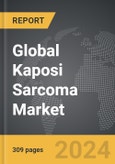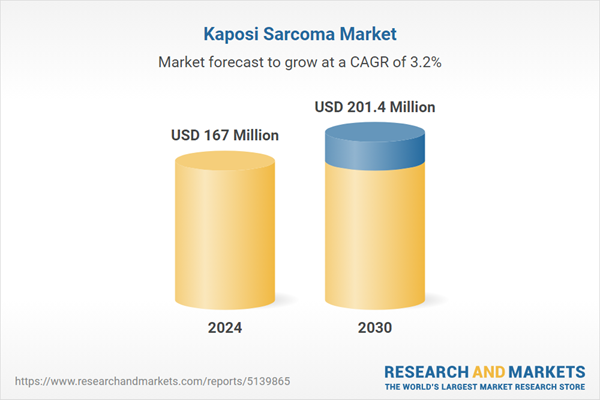The global market for Kaposi Sarcoma was valued at US$167.0 Million in 2024 and is projected to reach US$201.4 Million by 2030, growing at a CAGR of 3.2% from 2024 to 2030. This comprehensive report provides an in-depth analysis of market trends, drivers, and forecasts, helping you make informed business decisions. The report includes the most recent global tariff developments and how they impact the Kaposi Sarcoma market.
Segments: Treatment Type (HAART, Chemotherapy, Immunotherapy).
Geographic Regions/Countries: World; United States; Canada; Japan; China; Europe (France; Germany; Italy; United Kingdom; and Rest of Europe); Asia-Pacific; Rest of World.
The analysts continuously track trade developments worldwide, drawing insights from leading global economists and over 200 industry and policy institutions, including think tanks, trade organizations, and national economic advisory bodies. This intelligence is integrated into forecasting models to provide timely, data-driven analysis of emerging risks and opportunities.
Global Kaposi Sarcoma Market - Key Trends & Treatment Innovations
Why Is Kaposi Sarcoma a Significant Concern in Oncology?
Kaposi Sarcoma (KS) is a rare form of cancer that develops from the cells that line lymph or blood vessels and is most commonly associated with immunocompromised individuals, particularly those with HIV/AIDS. It manifests as lesions on the skin, but it can also affect internal organs, making it a significant concern in oncology due to its aggressive nature and the complications it can cause. While KS was once considered relatively rare, the rise of the HIV/AIDS epidemic dramatically increased its prevalence, particularly in regions with limited access to antiretroviral therapy (ART). Despite advancements in HIV treatment, Kaposi Sarcoma remains a critical issue, especially in sub-Saharan Africa, where it is one of the most common cancers due to the high rates of HIV infection and limited access to healthcare.How Are Treatment Approaches for Kaposi Sarcoma Evolving?
Treatment approaches for Kaposi Sarcoma are evolving, driven by advancements in both oncology and HIV/AIDS treatment. The primary treatment for KS involves antiretroviral therapy (ART), which helps control HIV infection and, consequently, can lead to the regression of KS lesions. However, in cases where KS is more aggressive or does not respond adequately to ART, additional treatments such as chemotherapy, radiation therapy, and targeted therapies are employed. Recent developments in targeted therapy and immunotherapy are offering new hope for patients with refractory KS. Drugs that specifically target the molecular pathways involved in KS are showing promise in clinical trials, offering the potential for more effective and less toxic treatments. Moreover, advancements in understanding the role of the human herpesvirus 8 (HHV-8), which is strongly associated with KS, are paving the way for novel therapeutic strategies aimed at preventing or treating this cancer more effectively.What Challenges Exist in the Treatment and Management of Kaposi Sarcoma?
The treatment and management of Kaposi Sarcoma present several challenges, particularly in resource-limited settings. One of the primary challenges is the early detection and diagnosis of KS, especially in regions where healthcare infrastructure is underdeveloped. Many cases of KS go undiagnosed or are diagnosed at a late stage, when the disease is more difficult to treat. Additionally, the stigma associated with HIV/AIDS can prevent individuals from seeking timely medical care, further complicating the management of KS. Access to treatment is another significant challenge, as many patients in low-income regions do not have access to ART or the necessary oncology care. Furthermore, even in regions with better healthcare infrastructure, there is still a need for more effective therapies with fewer side effects, as current treatment options can be limited in their efficacy and tolerability. Addressing these challenges requires a multifaceted approach, including improving access to ART, enhancing diagnostic capabilities, and developing more effective and accessible treatments.What Factors Are Driving Research and Treatment Advancements in the Kaposi Sarcoma Market?
The growth in the Kaposi Sarcoma treatment market is driven by several factors, including the ongoing HIV/AIDS epidemic, advancements in cancer research, and the development of targeted therapies. The continuing prevalence of HIV, particularly in regions like sub-Saharan Africa, underscores the need for effective treatments for KS. The expansion of ART programs globally has significantly impacted KS incidence and treatment outcomes, driving demand for integrated HIV and cancer care. Additionally, the progress in cancer research, particularly in understanding the molecular and viral mechanisms underlying KS, is leading to the development of more targeted and effective treatments. The growing interest in immunotherapy and targeted therapies is also contributing to market growth, as these approaches offer new hope for patients with treatment-resistant KS. As research continues and access to advanced treatments improves, the KS treatment market is expected to expand, offering better outcomes for patients worldwide.Report Scope
The report analyzes the Kaposi Sarcoma market, presented in terms of units. The analysis covers the key segments and geographic regions outlined below.Segments: Treatment Type (HAART, Chemotherapy, Immunotherapy).
Geographic Regions/Countries: World; United States; Canada; Japan; China; Europe (France; Germany; Italy; United Kingdom; and Rest of Europe); Asia-Pacific; Rest of World.
Key Insights:
- Market Growth: Understand the significant growth trajectory of the HAART segment, which is expected to reach US$101.5 Million by 2030 with a CAGR of a 3.2%. The Chemotherapy segment is also set to grow at 2.5% CAGR over the analysis period.
- Regional Analysis: Gain insights into the U.S. market, valued at $45.3 Million in 2024, and China, forecasted to grow at an impressive 3.1% CAGR to reach $32.2 Million by 2030. Discover growth trends in other key regions, including Japan, Canada, Germany, and the Asia-Pacific.
Why You Should Buy This Report:
- Detailed Market Analysis: Access a thorough analysis of the Global Kaposi Sarcoma Market, covering all major geographic regions and market segments.
- Competitive Insights: Get an overview of the competitive landscape, including the market presence of major players across different geographies.
- Future Trends and Drivers: Understand the key trends and drivers shaping the future of the Global Kaposi Sarcoma Market.
- Actionable Insights: Benefit from actionable insights that can help you identify new revenue opportunities and make strategic business decisions.
Key Questions Answered:
- How is the Global Kaposi Sarcoma Market expected to evolve by 2030?
- What are the main drivers and restraints affecting the market?
- Which market segments will grow the most over the forecast period?
- How will market shares for different regions and segments change by 2030?
- Who are the leading players in the market, and what are their prospects?
Report Features:
- Comprehensive Market Data: Independent analysis of annual sales and market forecasts in US$ Million from 2024 to 2030.
- In-Depth Regional Analysis: Detailed insights into key markets, including the U.S., China, Japan, Canada, Europe, Asia-Pacific, Latin America, Middle East, and Africa.
- Company Profiles: Coverage of players such as Bristol-Myers Squibb Company, Eli Lilly and Company, GlaxoSmithKline PLC, Johnson & Johnson, Merck & Co., Inc. and more.
- Complimentary Updates: Receive free report updates for one year to keep you informed of the latest market developments.
Some of the 14 companies featured in this Kaposi Sarcoma market report include:
- Bristol-Myers Squibb Company
- Eli Lilly and Company
- GlaxoSmithKline PLC
- Johnson & Johnson
- Merck & Co., Inc.
- Pfizer, Inc.
Tariff Impact Analysis: Key Insights for 2025
Global tariff negotiations across 180+ countries are reshaping supply chains, costs, and competitiveness. This report reflects the latest developments as of April 2025 and incorporates forward-looking insights into the market outlook.The analysts continuously track trade developments worldwide, drawing insights from leading global economists and over 200 industry and policy institutions, including think tanks, trade organizations, and national economic advisory bodies. This intelligence is integrated into forecasting models to provide timely, data-driven analysis of emerging risks and opportunities.
What’s Included in This Edition:
- Tariff-adjusted market forecasts by region and segment
- Analysis of cost and supply chain implications by sourcing and trade exposure
- Strategic insights into geographic shifts
Buyers receive a free July 2025 update with:
- Finalized tariff impacts and new trade agreement effects
- Updated projections reflecting global sourcing and cost shifts
- Expanded country-specific coverage across the industry
Table of Contents
I. METHODOLOGYII. EXECUTIVE SUMMARY2. FOCUS ON SELECT PLAYERSIII. MARKET ANALYSISIV. COMPETITION
1. MARKET OVERVIEW
3. MARKET TRENDS & DRIVERS
4. GLOBAL MARKET PERSPECTIVE
UNITED STATES
CANADA
JAPAN
CHINA
EUROPE
FRANCE
GERMANY
ITALY
UNITED KINGDOM
REST OF EUROPE
ASIA-PACIFIC
REST OF WORLD
Companies Mentioned (Partial List)
A selection of companies mentioned in this report includes, but is not limited to:
- Bristol-Myers Squibb Company
- Eli Lilly and Company
- GlaxoSmithKline PLC
- Johnson & Johnson
- Merck & Co., Inc.
- Pfizer, Inc.
Table Information
| Report Attribute | Details |
|---|---|
| No. of Pages | 309 |
| Published | April 2025 |
| Forecast Period | 2024 - 2030 |
| Estimated Market Value ( USD | $ 167 Million |
| Forecasted Market Value ( USD | $ 201.4 Million |
| Compound Annual Growth Rate | 3.2% |
| Regions Covered | Global |









